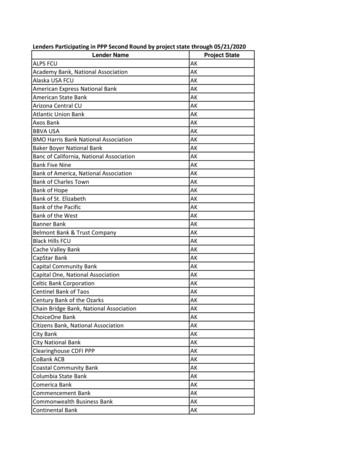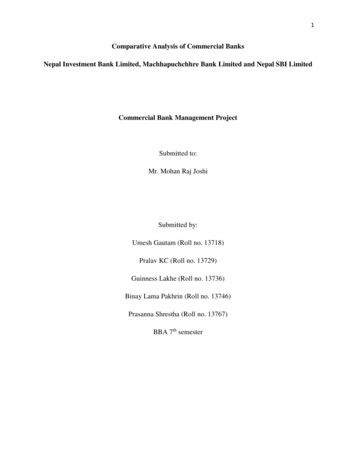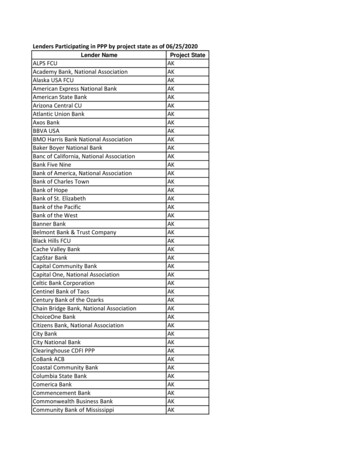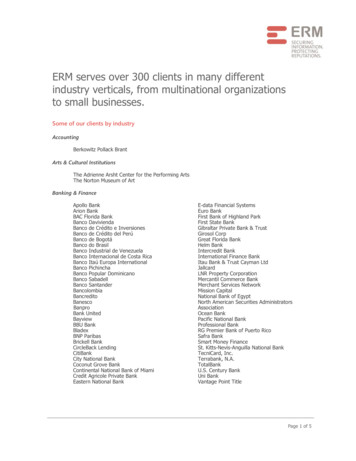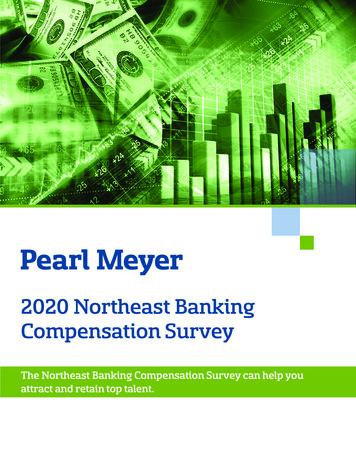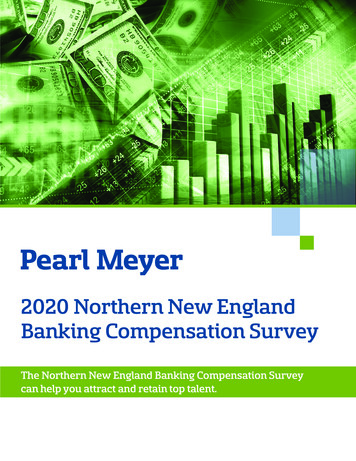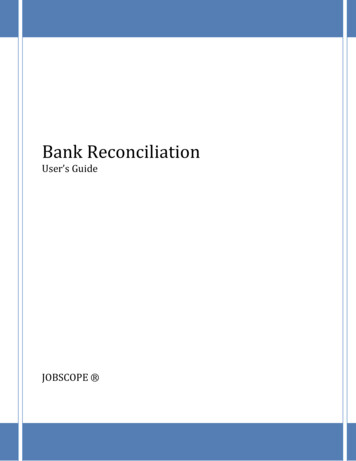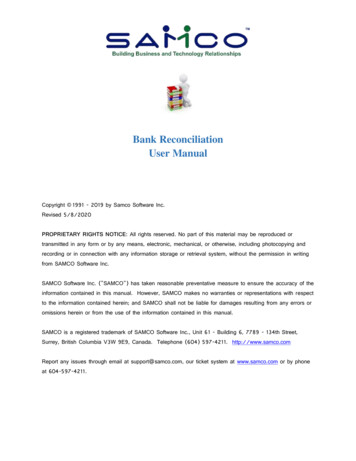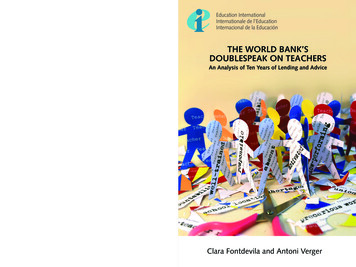
Transcription
Education InternationalInternationale de l’EducationInternacional de la EducaciónTHE WORLD BANK’SDOUBLESPEAK ON TEACHERSAn Analysis of Ten Years of Lending and AdviceEducationInternational5, boulevard du Roi Albert II - B-1210 Brusselswww.ei-ie.orgEducation International is the global union federation representing more than 32 millionteachers, professors and education workers from pre-school to university in more than 171countries and territories around the globe.ISBN 978-92-95109-01-8 (PDF)ISBN 978-92-95109-00-1 (Paperback)Clara Fontdevila and Antoni Verger
T H EW O R L DB A N K ’ SD O U B L E S P E A KEducation InternationalInternationale de l’EducationInternacional de la EducaciónO NT E A C H E R STHE WORLD BANK’SDOUBLESPEAK ON TEACHERSAn Analysis of Ten Years of Lending and AdviceClara Fontdevila and Antoni VergerGlobalization, Education and Social Policies (GEPS)Research Center – Department of Sociology,Universitat Autònoma de Barcelona20151
T H EW O R L DB A N K ’ SD O U B L E S P E A KO NT E A C H E R STABLE OF CONTENTSIntroduction51.1. Methodology71.2. Conceptual framework81.3. About this bookletTeachers in the World Bank’s knowledge products10112.1. Teachers and quality education: a multi-faceted relationship112.2. Teachers’ unions and educational reform182.3. Policy recommendations and advice222.4. What do emblematic publications say?302.5. Key findings37Teachers in the World Bank’s lending projects393.1. Teacher-related issues to be addressed393.2. What place for teachers’ unions?473.3. Main policy interventions493.4. Key findings57Conclusions584.1. Depiction of teachers in the knowledge products584.2. Treatment of teachers in lending projects594.3. Conceptions of general teacher policy: a comparative analysis61List of references67Appendices70Appendix 1. Synthesis Matrix70Appendix 2. List of Knowledge Products72Appendix 3. List of Lending Projects74Appendix 4. Data Collection instrument773
E D U C AT I O N I N T E R N AT I O N A L4
T H EW O R L DB A N K ’ SD O U B L E S P E A KO NT E A C H E R S1. INTRODUCTIONDuring the last few decades, the World Bank has become a central actor in shaping theglobal education policy agenda. Since the approval of its first education loan in 1962,this international organisation has become increasingly involved in education to thepoint of becoming the largest supplier of external funding to the sector. Importantly,the priorities or focus of attention of the World Bank (hereafter also ‘the Bank’ or theWB) in education have also evolved. Whilst it was mainly focused on the materialdimension of the education system (such as school infrastructure, textbooks, materialassets for workshops and laboratories, and so on), over time, more intangible issuesincluding learning outcomes and education quality have gained centrality in the Bank’slending portfolio (Jones, 2007; Mundy and Verger, 2015). As part of this shift, teacherpolicies have also received increasing attention in the Bank’s interventions. This focuson teachers on behalf of the Bank has been reinforced over the years following thefinding of the impact of teachers on student learning outcomes and, accordingly,on countries’ economic competitiveness (Robertson, 2012). Thus, by doing so, theWorld Bank joins a broader consensus that has been forged within the internationaldevelopment community concerning the key role that teachers potentially play in thepromotion of quality education for all (Leu, 2005; UNESCO, 2005), and that the wellknown 2007 McKinsey report brought to an end when sentencing that “the quality ofan education system cannot exceed the quality of its teachers” (McKinsey, 2007: 4).The prominent role of the World Bank in the global governance of education cannot beunderstood solely on the grounds of its material power. Hence, its capacity to influencepolicy goes beyond its lending activity and also involves a significant “ideational”power propagated through the production of knowledge, e.g., publishing of reports,academic articles, and policy briefs among other publications (Steiner-Khamsi, 2012;Verger et al., 2014). As recalled by Steiner-Khamsi (2012), the World Bank hasreinvented itself and now operates as a knowledge bank, acting increasingly as a“global policy advisor for national governments” and elevating itself “into the role ofthe ‘super think tank’ among the aid agencies that, based on its extensive analyticalwork, knows what is good for recipient countries but also what other aid agenciesshould support” (Steiner-Khamsi, 2012: 5). Similarly, Jones (2007) notes that Bankpolicies in education can be distinguished or identified by two main methods, namely:the observation of the accumulation of projects, and the body of different types ofpublications directed to influence common or global understanding of education5
E D U C AT I O N I N T E R N AT I O N A Lpolicy. In their study of the World Bank’s policy on education privatisation, Mundyand Menashy (2014) also distinguish between knowledge and lending products.Interestingly, they find that there is a disjuncture between the policy discourse andthe practice of the Bank regarding education privatisation, with an official discoursethat is more pro-privatisation than the actual operations on the ground.1Building on these insights, the main questions that inspire the present study are: Howare teachers conceived and portrayed in both the World Bank’s knowledge productsand in the lending projects financed by this organisation? Which are the teacherpolicies most commonly recommended and prescribed in both the World Bankpublications and operations? Specifically, the objectives of this study are to:1. Examine how teachers, as well as teachers’ unions, are characterised inthe World Bank’s knowledge products, or publications, that have beenreleased in the last decade, and determine what are the “teacher-relatedissues” most frequently emphasised in them.2. Find out which are the policy prescriptions recommended or advocatedfor in the World Bank’s knowledge products, with a focus on the level ofconsistency or logical correspondence between detected problems andproposed solutions.3. Review the policies and measures concerning teachers as stipulated inthe World Bank’s lending projects and guidelines (approved since 2005),identifying the practices and policy programmes most commonly put intopractice, as well as those problems intended to be addressed.4. Examine to what extent the World Bank’s operations reflect the discoursecontained in its more emblematic “knowledge products”, paying specialattention to possible inconsistencies (as per Mundy and Menashy’s (2014)analysis of the education privatisation agenda of the Bank mentionedabove).5. Based on the above analysis, determine the paradigm of teachers’ reformthat tends to predominate in the World Bank’s programmes and identifythe effects of this prevalence.61See also Menashy et al. (2012).
T H EW O R L DB A N K ’ SD O U B L E S P E A KO NT E A C H E R S1.1. MethodologyTo achieve these objectives, the present study has employed a content analysismethodology, understood as a set of techniques intended to collect information,produce indicators, and organise information through a systematic classification processof identifying, coding and counting themes, enabling the inference of characteristicsand meaning from a large corpus of written texts and/or to test previously establishedhypotheses (cf. Bardin, 1996 and Neuendorf, 2002). Taking into account the distinctionbetween policy and practice, which is central in the objectives of this research, twomain types of documents have been selected for analysis: (i) knowledge products,published by the World Bank, including policy briefs, technical reports, research papers,sector strategies and books; and (ii) lending projects of the World Bank, includingproject appraisal documents for specific investment loans, adaptable programmeloans and credits, sector development policy loans and credits, additional grants, andemergency recovery loans.The selection of the documents has been based on the following criteria:- Date: references between 2005 and 2014.- Education level: primary and secondary education.- Knowledge products: presence of the term ‘teacher(s)’ in the title or clear focuson teachers. Moreover, considering their particularly influential or “groundbreaking” nature, three additional documents have also been included inthe corpus: the World Bank Education Strategy 2020, the Systems Approachfor Better Education Results (SABER)-Teachers Framework documents, andthe book, Making Schools Work: New Evidence on Accountability Reforms.In this booklet, these documents are taken separately and presented inindependent boxes, although they are also included in the corpus ofknowledge products collected for the general analysis.- Lending projects: projects included one of the teacher-related categoriesaccording to the categorisation provided by the World Bank EducationProjects Database.A total of 48 knowledge documents and 133 lending projects’ documents have beenidentified according to these criteria (see Appendices 2 and 3). Each document hasbeen examined on the basis of a previously set list of categories that has enabled theidentification of teacher-related problems and their attributed causes, recommendedor prescribed policies, and inclination toward teachers’ unions. In order to proceedwith the codification of the selected documents, a repertoire of items and themesinductively defined has enabled the identification of those problems and policies more7
E D U C AT I O N I N T E R N AT I O N A Lfrequently considered in the corpus of reviewed documents. This list has constitutedthe basis for the data collection instrument, under the form of a synthesis matrix(see Appendix 4). As part of teachers’ related data, more descriptive data, includinggeographical area, date and ‘genre’ of the document has also been collected withthe aim of discerning possible patterns based on these features. The synthesis matrixused in the process can be consulted in Appendix 1.The codification process has enabled the quantification of types of predominantapproaches in the selected documents on a range of teachers’ related matters. In thecase of knowledge products, this quantification evidences the themes and questionsthat orient the policy and research agendas of the Bank – revealing what this institutionidentifies as the main challenges or “issues” in relation to teachers. Moreover, theidentification of a range of policy options and the stance taken by the Bank regardingthese practices reveal the policy preferences of the institution. Similarly, in relation tolending projects, the authors quantified the “issues” most frequently requiring theWB’s attention and the commonly prescribed policies, both illuminating the Bank’sviews on the weak points and necessary solutions with respect to teachers.1.2. Conceptual frameworkWithin the international education community there is broad consensus on the keyrole of teachers in the improvement of education systems, yet there is not such anagreement concerning which specific types of teachers’ policies and accountabilitymeasures can contribute to promote quality education more effectively. Scholars,such as Cochran-Smith (2000, 2001), Connell (2009) and Zeichner (2003) havedistinguished between different - and even competing - teachers’ reform agendas,including professionalisation, deregulation, over-regulation, and social justice agendas.On their part, Maroy (2008) and Maroy and Voisin (2013) have categorised differentmodes of institutional regulation of education systems (namely, bureaucraticprofessional models and post-bureaucratic models, including a quasi-market and anevaluative state approach), as well as distinct understandings of teachers’ accountability– some of them more supportive of a teachers’ professionalisation agenda and some ofthem more supportive of a deregulation agenda. In the same vein, Mons and Dupriez(2010) distinguish between hard, soft, and reflexive accountability policies. Building onthese notions of teacher development and accountability reforms, four (competing)and general teacher policy agendas can be distinguished:282The fact that these categories – which will be used to analyse the documents that are part of theresearch corpus - are grounded on existing literature on teachers’ policy and accountability reformsensures both their theoretical adequacy and their analytical value.
T H EW O R L DB A N K ’ SD O U B L E S P E A KO NT E A C H E R S- Professionalisation agenda. This agenda puts emphasis on pre-serviceand in-service training and practical experience for novice teachers andpromotion of in-school and peer-based forms of professional developmentand mentorship and induction programmes; preference for selective preservice training programmes and high professional qualifications standards;teachers’ welfare; labour regularisation, and public recognition.- Competition and/or market agenda. The main measures contemplatedhere are the promotion of contract and/or para-teachers: flexible andalternative paths of entrance to the profession and preference for schoolbased management (community or school councils enjoying substantialdecision-making power regarding staff hiring and firing).- Managerialist or neo-bureaucratic agenda. This agenda emphasises highstakes testing and the need for policies facilitating dismissals (probationperiods, performance-based tenure); promotion of performance-basedincentives (bonuses, awards, career advancement opportunities and pay)and attention to monitoring and evaluation systems and the improvementof human resources management; and principals’ decision-making poweron staff management.- E fficiency driven agenda. This agenda pays attention to teachers’deployment policies (need for hardship bonuses and the revision of transfercriteria), contract teachers, emphasis on the optimisation of pupil-teacherratios and promotion of multi-grade instruction.To a great extent, these categories will guide our review of the World Bank documentsand interventions affecting teachers. By identifying and quantifying the WB’s policypreferences included in our sample of documents, we will be able to discuss which ofthese different agendas predominates in the Bank’s approach to teachers’ reforms.This analysis will be conducted by assuming that a particular constellation of policiesadvanced in the reviewed documents is indicative of the priority given to each one ofthese agendas. However, it is also important to mention that these teachers’ reformagendas are conceived as ‘ideal types’ as the authors do not expect them to crystallisein a pure form in real situations. Accordingly, in the World Bank’s policies on teachers,the authors expect to identify some hybrid agendas or constellations of policies thatcould correspond to rather different reform approaches.9
E D U C AT I O N I N T E R N AT I O N A L1.3. About this bookletOverall, this booklet shows that the World Bank does not have a monolithic visionon teachers nor does it advocate for a unique package of teacher-related policies.The different documents analysed in this review reflect very diverse points of viewcoexisting within this international organisation on the same teacher-related themes(such as the contribution of teachers to education quality, the role of teachers’ unionsin educational reform, and so on). At the same time, different and, at times, conflictingteachers’ reforms and policies are advocated by the Bank. Although some commonpatterns can be identified in both knowledge products and lending projects, there isan evident tension in the teachers’ conceptions and policies identified across thesetwo types of documents. Broadly speaking, it could be considered that the WorldBank knowledge products reflect a certain preference for a managerialist or neobureaucratic agenda and are especially concerned with teachers’ lack of effort in manyeducational settings. On the other hand, the World Bank’s lending projects seem tobe more supportive of a professionalisation agenda and place a greater emphasis onthe necessity of improving teachers’ training.This study’s findings also suggest that there is an important degree of regional variationin the World Bank’s approach to teachers. For instance, in relation to lending projects,the promotion of controversial reforms such as contract teachers, school-basedmanagement, and performance-based incentives is particularly present in the SouthAsia region, but is not so evident in other regions. The conception of teachers’ unionsalso varies noticeably among the different regions where the Bank operates. Teachers’unions in Sub-Saharan Africa are conceived as a potential ally in numerous WorldBank publications and projects, whereas these teachers’ organisations are especiallystigmatised in the World Bank literature on Latin American education.This booklet presents these and many other findings in three main sections. In thefirst section, the content of the World Bank’s research products focusing on teachersis analysed. The second section concentrates on the analysis of those World Bank’slending projects with teachers’ components. The third and final section discusses themain results from a comparative perspective and presents the main conclusions of theresearch. In particular, this last section explores the possible reasons for the observedgap between “talk and action” in the World Bank’s approach to teachers’ reforms.10
T H EW O R L DB A N K ’ SD O U B L E S P E A KO NT E A C H E R S2. T EACHERS IN THE WORLD BANKKNOWLEDGE PRODUCTSDrawing on a corpus of WB knowledge products, this section aims to capture howteachers are considered to contribute to education quality, and which policy optionsare recommended to strengthen the link between teachers and education quality.Section 2.1 explores the range of “teacher issues” that are considered to impinge oneducation quality, including the preferred explanations of why teachers represent achallenge for educational quality in many developing contexts. Section 2.2 deals withhow the WB’s knowledge products characterise teachers’ unions, and outlines therelated policy advice for governments on how to engage with this type of organisation.Section 2.3 addresses the preferred policy options outlined in Bank publications forintervening in a range of teacher-related areas such as teachers’ labour conditions,teacher training, and so on. This section ends with a more in-depth discussion ofthree emblematic World Bank documents that directly engage with teachers’ debates.2.1. Teachers and quality education: a multi-faceted relationship2.1.1. A “far from satisfactory” contributionIn general terms, the World Bank literature conceives teachers as key agents instudents’ learning, but it tends to do so by portraying teachers as poor contributorsto the quality of education systems, if not ultimately responsible for the limited levelsof student learning. In fact, one-third of the examined documents make explicitreference to the uneven levels of teacher effectiveness or to the effects of individualteachers on students’ test scores. One of the central tenets of the Bank is that the‘quality’ or ‘effectiveness’ of teachers is the main (school-based) factor affectingstudent achievement. “A series of great or bad teachers over several years compounds these effects and canlead to unbridgeable gaps in student learning levels. No other attribute of schoolscomes close to this impact on student achievement” (Bruns and Luque, 2014: 6).3 “Quality teachers are one of the most important school-related factors found tofacilitate student learning and likely explain at least some of the difference ineffectiveness across schools” (Loeb et al., 2012: 271).3 Here, the authors remark on the impact of teacher effectiveness on students’ mastery of the curriculum, college participation rates, and subsequent income.11
E D U C AT I O N I N T E R N AT I O N A L “The broad consensus is that teacher quality is the single most important schoolvariable influencing student learning (Darling-Hammond, 2000; Rockoff, 2004;Rivkin, Hanushek and Kain, 2005)” (Pandey et al., 2008: 13). “A number of studies have found that teacher effectiveness is the most importantschool-based predictor of student learning and that several consecutive years ofoutstanding teaching can offset the learning deficits of disadvantaged students”(World Bank, 2012: 5).2.1.2. Lacking professionalismHowever, the explanations for the poor quality of teachers and teaching practices arequite varied in nature. A first group of “symptoms”, and by far the most frequentlydocumented, are those related to the idea of “lack of effort”, “deliberate negligence”,or “lack of professionalism” (46.88 per cent of WB knowledge products). Hence, anoticeable number of documents 4 conceive teachers as dishonest employees likelyto have a casual attitude to work. Nearly half of the documents analysed make somereference to poor teaching as a consequence of idleness during instructional hours (asopposed to a hard-working or industrious attitude), including an intentional loss ofinstruction time, a poor use of available material, a deliberate neglect of responsibilities,inactivity or lack of engagement when in the classroom, deliberate absenteeism, andunofficial “shortenings” of the school day or week.Among these factors, absence rates are at the centre of the World Bank’s discourseon teachers’ attitudes. References to non-attendance or absenteeism can be found inthree-quarters of the reviewed publications, usually regarded as an important factorcontributing to poor learning outcomes. Thus, the idea of the absent teacher is clearlya pervasive one in the Bank’s literature. Two seminal works, repeatedly referenced inthe reviewed publications, are the most important source of evidence on the matter forthe Bank, namely, the work of Chaudhury et al. (2006)5 and of Kremer et al. (2005).645If not stated otherwise, knowledge products do not include SABER-Teachers’ country cases.Chaudhury, N., Hammer, J., Kremer, M., Muralidharan, K., and Rogers, F. H. (2006). “Missing inAction: Teacher and Health Worker Absence in Developing Countries.” Journal of Economic Perspectives 20 (1): 91–116, and the variation. Chaudhury, N., Hammer, J., Kremer, M., Muralidharan,K., and Rogers, F. H. (2004). “Teacher and Health Care Provider Absenteeism: A Multi-CountryStudy.” World Bank: Washington, DC.612Kremer, M., Chaudhury, N., Rogers, F. H., Muralidharan, K., Hammer, J. (2005). “Teacher Absencein India: A Snapshot.” Journal of the European Economic Association 3 (2–3): 658–67. Also foundas Chaudhury, N., M. Kremer, F. H. Rogers, J. Hammer, and K. Muralidharan (2005). “Teacher Absence in India: A Snapshot.” Journal of the European Economic Association 3 (2–3): 658–67.
T H EW O R L DB A N K ’ SD O U B L E S P E A KO NT E A C H E R SBOX 1. MANAGING INSTRUCTIONAL TIMEThe loss of instructional time is addressed by a number of lending projects,constituting a distinct category of problems (see next section). Attention tothis issue seems to owe much to the work of Abadzi (2007), who spent almost30 years as senior education specialist at the World Bank. Abadzi emphasisesthe relationship between instructional time and student achievement, notingthat “variables measuring curricular exposure are strong predictors of testscores and correlations between content exposure and learning are typicallyhigher than correlations between specific teacher behaviours and learning”(p. 17). Her work draws attention to the fact that, in poor areas, the lossof instructional time is particularly striking, and she developed a “time lossmodel” that considers the effect of school closures, teacher absenteeismand tardiness, student absenteeism, non-instructional time (organisation andmanagement activities) and deviations from prescribed curriculum. Albeitadmitting that these losses are sometimes legitimate or involuntary, the policyguidance recommended by her study emphasises the need for accountability,monitoring, and control mechanisms, suggesting that the poor use of time isconsidered the result of a deliberate decision in a context of weak supervision.2.1.3. A matter of accountabilityIn many of the Bank publications, issues of under-performance and deliberateabsenteeism go hand-in-hand with explanations pointing to the ineffectiveness orabsence of supervisory structures and, in particular, a lack of accountability systems.It is suggested that teachers do not make an effort (or shirk their responsibilities) asa consequence of not being held directly accountable for student learning. Up to43.75 per cent of the documents allude to a “lack of performance-based incentives”,and consider that fixed wages, job stability, and promotions that are unresponsiveto performance levels demotivate teachers and keep incompetent individuals in theprofession. Among this group of documents, some call into question permanent tenureor open-ended appointments, while others make reference to systems that rewardcredentials rather than performance, absence of performance-based bonuses, orpre-arranged and invariable salaries. In fact, the notion of “incentive” (as an elementlikely to encourage good performance and effort) includes a variety of interpretations,ranging from monetary and non-monetary rewards to the “fear” of job loss. In anycase, the perceived harmful effects of uniform and equal labour conditions (regardlessof performance) emerge as a cross-cutting idea within these documents. The followingexcerpt captures and synthesises this widespread approach:13
E D U C AT I O N I N T E R N AT I O N A L “Most education systems globally are characterized by fixed salary schedules,lifetime job tenure, and flat labor hierarchies, which create a rigid laborenvironment where extra effort, innovation, and good results are notrewarded and where dismissal for poor performance is exceedingly rare(Weisberg and others, 2009)” (Bruns, Filmer and Patrinos, 2011: 18)While many of the documents point to a lack of accountability to education authorities(or to an undefined agent), a second group of documents refers more explicitly toan insufficient accountability of teachers towards parents, school communities, orlocal communities. Specifically, 28.13 per cent of the knowledge products point to aninadequate monitoring of teachers (and, more particularly, teachers’ attendance) bycitizens, who are conceived as the ultimate consumers of education. In this narrative,it is assumed that the lack of “voice” or feedback opportunities by the so-callededucation clients account for the existence of neglectful teachers. Among otherissues, these documents refer to a lack of “real” decision-making power (e.g. schoolcouncils unable to hire and fire school staff), self-perceived disempowerment amongfamilies (as in the case of parents with low levels of education attainment), or a lackof interest/awareness among communities about their own responsibilities concerningteachers’ management.2.1.4. Mitigating responsibilityAlthough less frequently than accountability related explanations, an importantnumber of the documents (34.38 per cent) consider a range of mitigating factorsthat effect the degree of teachers’ responsibility for their own poor performanceand non-attendance. These are “extenuating circumstances” affecting teachers(i.e. factors beyond teachers’ control) including the effect of school location (rural orremote areas), the impact of illness-related factors (particularly HIV/AIDS affectingteachers or teachers’ relatives), external obligations (such as electoral duties), the needto travel to collect salaries or participate in training, and the impact of second jobs(“moonlighting” resulting from low salaries) or double-shift schemes.7Importantly, this group of explanations gives rise to a highly polarised distinctionbetween two competing approaches regarding teacher absence, as shown in Figure 1.714 The consideration of non-deliberate absenteeism or the “refinement” in causal explanations seemsto be particularly the case for those reports that form part of the collection Africa Human Development Series, produced “in the field” (as opposed to those produced by Washington-based teams orresearchers).
T H EW O R L DB A N K ’ SD O U B L E S P E A KO NT E A C H E R SAt one end of the spectrum, half of the publications documenting absence rates regardthem as the result of a deliberate neglect.8 At the other end of the spectrum, anotherhalf of the publications dealing with teacher absence consider factors that are outsideof teachers’ control. The existence of these two competing approaches regardingteacher absence, and the tension this generates when it comes to the construction ofcoherent policy diagnoses, is well captured in the following excerpt: “In attributing all teacher absence to negative shocks, we have probablybeen overly generous–it is likely that at least some portion of teacherabsence is due to shirking rather than illness ( ) The situation in lowincome countries may be very different. Certainly, studies in India(Chaudhury and others, 2005) suggest that teacher absenteeism is largelydue to shirking rather than illness. Jacobson’s work however, cautionsus in extrapolating views from one continent to another. If teachers inZambia and other Sub-Saharan countries are absent because they shirkand incentive schemes and greater accountability lead both to greaterattendance and better performance, then such schemes can lead to betterlearning outcomes. However, if teachers’ utility functions are altruisticso that most absenteeism is “genuine”, incentive schemes might hurtteacher motivation” (Das et al, 2005: 20-21). “One note on terminology: The term ‘absenteeism’ is widely used in thisliterature. In this chapter, we prefer the term ‘absence’, which we view as
teachers, professors and education workers from pre-school to university in more than 171 countries and territories around the globe. ISBN 978-92-95109-01-8 (PDF) ISBN 978-92-95109-00-1 (Paperback) THE WORLD BANK’S DOUBLESPEAK ON TEACHERS An Analysis of Ten Years of Lending and Adv


